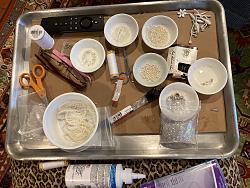If you've ever tried to pick up a spherically-shaped object with conventional tweezers, you're probably familiar with the sharp "ting" as the object springs out of the tweezers and rebounds off a distance wall into a dark recess.
The preferred tool for dealing with this situation is pearl tweezers, shown at the top in the photo below. Formed hemispherical cups on the ends of the tines securely grasp spheres and other shapes lacking parallel sides. A rubbery coating on the cups makes them tacky enough to discourage the object held from sliding out of the grasp. Their primary purpose, as the name suggests, is for handling pearls but, even if you don't make jewelry, they can be very handy in the shop.
If you don't handle a lot of small, oddly-shaped parts, you may be reluctant to buy pearl tweezers. However, that doesn't mean you have to deny yourself their utility if a job requiring them pops up. It takes only a few minutes to make a pair.
Take two Starbucks coffee stirrers, apply wood glue to about 1" of the ends and clamp them together. When the glue is dry, drill a suitable hole through the tip opposite the glue joint. (In the sample shown I drilled a 1/8" hole but the size can be adjusted to the task at hand.) Place a bit of wire between the two stirrers to spread them to your desired gap and, voila, you have your very own non-conducting pearl tweezers.
This size is perfect for holding the standard 4.5 mm BB while loading the clip on my raccoon dissuader pistol...
One of my 4.5 mm pellet rifles has a large telescopic sight which makes loading individual pellets (it's single shot) awkward with large 76 year old fingers. As this picture shows, the Starbucks pearl tweezers do a nice job holding the pellet in the right orientation to drop into the receiver...
This idea lends itself well to other variants. One I can think of is making a pair of cylindrical tweezers, e.g....
https://www.amazon.com/Hakko-578-SA-...rical+tweezers
A small block of wood would be used to separate the two stirrers at the glued end in order to create a greater gap between them. At the business end, two small blocks would be glued, one to each stirrer. Prior to splitting these blocks they would have been drilled with either longitudinal or transverse hole of the right size to the job at hand.


 LinkBack URL
LinkBack URL About LinkBacks
About LinkBacks





 Reply With Quote
Reply With Quote





Bookmarks